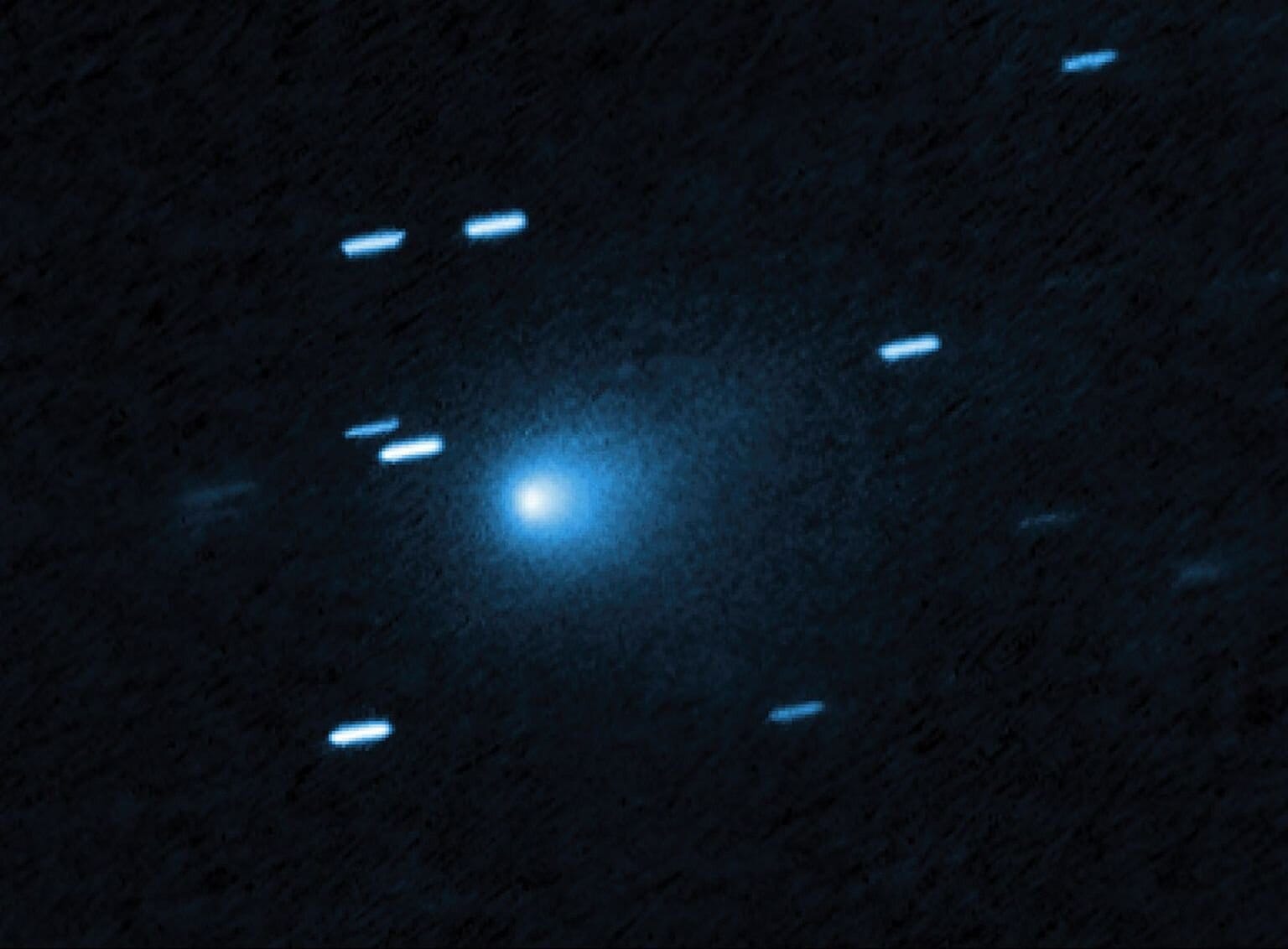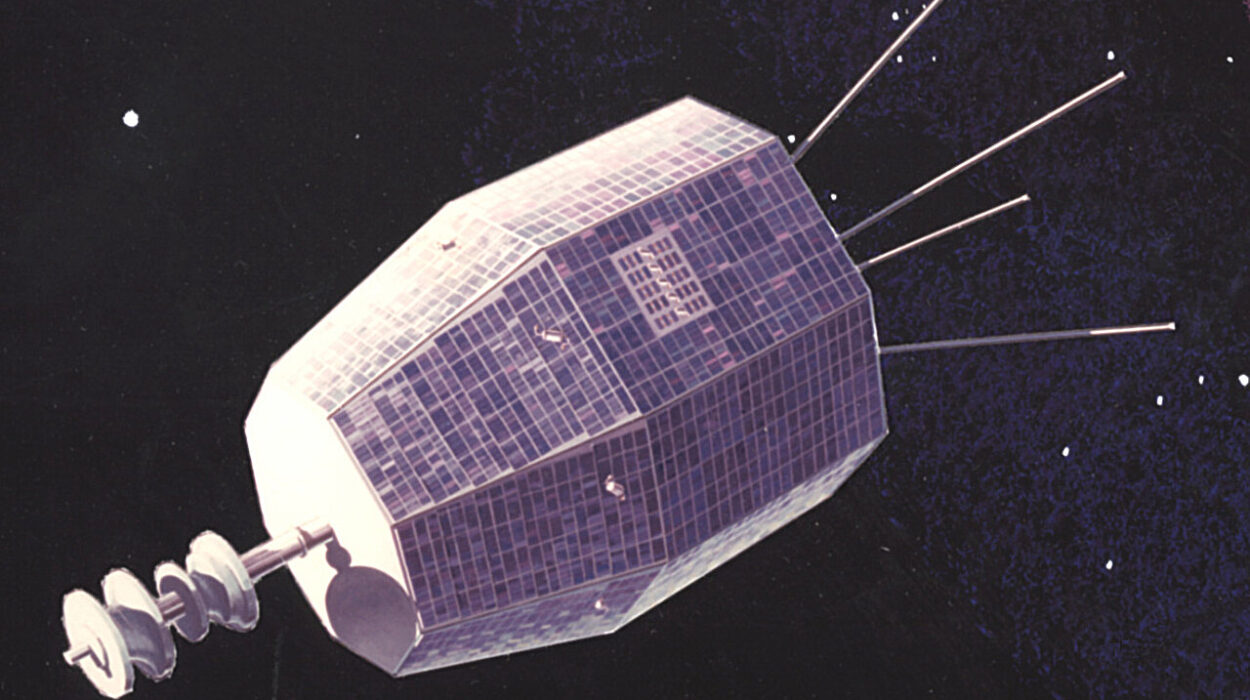In a moment of celestial clarity, NASA’s Hubble Space Telescope has captured the most detailed image yet of a mysterious interstellar object racing through our solar system. Known as 3I/ATLAS, this cosmic wanderer is only the third interstellar object ever detected by humanity—and it’s proving to be a captivating enigma.
Flying at an incredible 130,000 miles per hour (209,000 kilometers per hour), this icy traveler is not bound by our Sun’s gravity and will never return. It is a messenger from another star system, a silent time capsule flung across the galaxy, offering us a fleeting chance to peer into the deeper workings of our Milky Way.
Hubble’s Vision Unveils a Hidden Heart
While the comet’s icy heart remains hidden beneath a cloud of gas and dust, Hubble’s extraordinary resolution has brought us closer than ever to understanding its inner secrets. Astronomers now estimate that the nucleus of 3I/ATLAS measures no more than 3.5 miles (5.6 kilometers) wide—but it could be significantly smaller, possibly just 1,000 feet (320 meters) across.
Even for the powerful Hubble, the solid core of the comet is veiled beneath the glow of sunlight striking volatile materials on its surface. These materials—ices rich in carbon monoxide, water, and other compounds—vaporize when warmed, creating a glowing coma and long tail that define the familiar shape of a comet. But beneath this halo lies the object’s true body: ancient, unweathered, and alien in origin.
“This is a remarkable achievement,” said David Jewitt of the University of California, Los Angeles, the science team leader for Hubble’s 3I/ATLAS observations. “We’re placing tighter constraints than ever before on the nature of an object that began its journey billions of years ago, somewhere far beyond our solar system.”
Dust, Light, and Echoes of Familiar Comets
Hubble’s crisp images show a sun-warmed side of the comet throwing off dust in a steady plume, along with a faint tail trailing behind the object as it sprints toward and past the inner solar system. The dust-loss rate—how much material the comet sheds per second—is in line with comets that originate within our solar system. That alone is astonishing.
What does it mean when an object from another star system behaves so similarly to our local comets? It suggests that comet formation may be a universal process, shaped by the same laws of physics throughout the galaxy. In short, 3I/ATLAS is alien—but not unfamiliar.
“The dust production is what you’d expect from a sunbound comet first seen about 300 million miles from the Sun,” said Jewitt. “But this one comes from a completely different neighborhood.”
The Race of a Cosmic Bullet
Unlike comets that loop around the Sun in predictable orbits, 3I/ATLAS is following a hyperbolic trajectory—a curved path that will carry it in and then out of our solar system forever. Its record-breaking speed is no accident. Over countless millennia, as it drifted through the interstellar medium, the comet was subtly nudged by gravitational interactions with stars, planets, and nebulae. These random cosmic encounters added up, accelerating it to its current astonishing velocity.
Imagine a snowball being tossed through a field of invisible giants, each giving it a push. Now imagine that snowball hurtling through our solar system, glowing and shedding its icy layers as it tastes sunlight for the first time in eons. That is what 3I/ATLAS is.
“No one knows where the comet came from,” Jewitt explained. “It’s like glimpsing a rifle bullet for a thousandth of a second. You can’t project that back with any accuracy to figure out where it started on its path.”
Interstellar Visitors: A Growing Family
When the first interstellar object, ‘Oumuamua, was spotted in 2017, it stunned scientists and the public alike. Its cigar-shaped silhouette and strange acceleration sparked both awe and controversy. In 2019 came Borisov, the first interstellar comet observed behaving like its local cousins, trailing gas and dust.
Now, 3I/ATLAS joins this rare family. Its name reflects that: “3I” marks it as the third known interstellar object, and “ATLAS” honors the Asteroid Terrestrial-impact Last Alert System, a Hawaiian-based early warning system that discovered the comet on July 1, 2025, when it was 420 million miles from the Sun.
These are not random detections. They are the result of technological leaps in sky surveys and space telescopes. Thanks to new instruments like ATLAS and the wide-field scans of projects such as Pan-STARRS and the upcoming Vera C. Rubin Observatory, our ability to spot fast, faint visitors from beyond the solar system has dramatically improved.
“This latest interstellar tourist is one of a previously undetected population of objects bursting onto the scene that will gradually emerge,” said Jewitt. “We’ve crossed a threshold.”
Eyes on the Comet: A Fleet of Telescopes Joins In
NASA’s network of space observatories is working together to make the most of this rare opportunity. Alongside Hubble, telescopes like the James Webb Space Telescope (JWST), the Transiting Exoplanet Survey Satellite (TESS), and the Neil Gehrels Swift Observatory are poised to gather critical data. Even Earth-based observatories like W.M. Keck in Hawai‘i are lending their lenses.
Each telescope offers something different. JWST, for example, can examine the comet’s infrared signature, providing insight into its chemical composition and revealing the presence of organic molecules, water vapor, or frozen gases. TESS and Swift may detect light variations that hint at rotation or activity on the comet’s surface.
Combined, these observations will build a profile of 3I/ATLAS more detailed than any previous interstellar object. What elements were forged in the heart of another star and now streak before our eyes? What does its structure say about the worlds that orbit distant suns? And could such objects one day deliver the building blocks of life across the stars?
A Race Against the Sun
While 3I/ATLAS poses no threat to Earth, its passage offers only a brief window for scientific inquiry. The comet should remain visible to powerful ground-based telescopes through September 2025, after which it will pass too close to the Sun to be safely observed. However, it is expected to re-emerge by early December, offering a second and final glimpse before it disappears into deep space forever.
This ticking clock adds urgency to the global effort to study the comet in every possible way. There is no plan to send a spacecraft—not this time. But the idea of intercepting an interstellar object remains a tantalizing dream for the future, with space agencies already imagining fast-response missions that could one day touch or even return samples from one of these ghostly visitors.
A Message in a Shimmering Trail
Why do these interstellar objects matter so deeply to us? It’s not just the science—though the data they carry may rewrite textbooks on planetary formation. It’s also the perspective. In a universe that often feels impossibly vast and indifferent, an interstellar comet is proof that paths cross, that distant worlds can leave traces in our sky, that we are not isolated points in the dark.
3I/ATLAS is more than just ice and rock. It is a survivor of cosmic violence, flung from the cradle of an unknown star, wandering for eons through the great black sea, only to find itself briefly illuminated by a sun it had never met.
And for a short time, we can look up and say: There it is. We see you. We welcome you.
The Legacy of a Cosmic Encounter
Soon, 3I/ATLAS will vanish beyond the reach of our instruments, just another speck among the stars. But the data it leaves behind will linger—cataloged in observatories, studied by scientists, and perhaps one day inspiring new missions to chase down others like it.
It also leaves behind something less tangible, but just as important: a sense of wonder. That in the darkness between stars, ancient travelers roam. That with enough curiosity, cooperation, and ingenuity, we can catch a glimpse. That our tools—the gleaming eyes of our space telescopes—can stretch across billions of miles to touch the unknown.
In the end, 3I/ATLAS reminds us of what Einstein once said:
“The most beautiful experience we can have is the mysterious. It is the fundamental emotion which stands at the cradle of true art and true science.”
And in that comet’s fading tail, we find mystery enough to last a lifetime.
More information: David Jewitt et al, Hubble Space Telescope Observations of the Interstellar Interloper 3I/ATLAS, arXiv (2025). DOI: 10.48550/arxiv.2508.02934






